Track
The GROUP BY clause in SQL is a powerful tool that aggregates data based on one or more columns. It enables data analysts to summarize large datasets by grouping rows that share common values, making it easier to identify patterns, trends, and outliers.
While grouping by a single column is common, grouping by multiple columns allows more advanced and granular analytics. This method allows users to track metrics across multiple dimensions, such as periods, regions, or product categories. Grouping by multiple columns in business intelligence allows organizations to enhance reporting accuracy, better segmentation, and tailor analyses to complex business questions.
In this guide, I will explain how the GROUP BY clause works, advanced grouping methods, and best practices. If you are new to SQL, consider starting with our Introduction to SQL course or Intermediate SQL course to build a strong foundation. Also, I find the SQL Basics Cheat Sheet, which you can download, is a helpful reference because it has all the most common SQL functions.
Fundamentals of GROUP BY in SQL
Before I explain how to group by multiple columns in SQL, let’s first understand the basic concepts of the GROUP BY clause.
Basic principles of GROUP BY
The GROUP BY clause in SQL organizes identical data into groups. It scans rows in a database and then clusters rows with the same values in the specified columns, enabling data aggregation within these groups.
You can use the GROUP BY clause with aggregate functions such as COUNT(), SUM(), AVG(), MIN(), and MAX() to perform calculations for summaries on each group of rows.
Suppose you're analyzing sales data and want to know the total revenue per region. GROUP BY allows you to group sales by region and compute the sum for each in a single query.
Transitioning from single-column to multiple-column grouping
The database processes the GROUP BY clause on a single column by scanning through the rows and segmenting them according to the distinct values in that column. Each distinct value forms a group, and aggregation functions calculate results within each group.
However, when you introduce multiple columns, SQL groups the data based on every unique combination of those columns. This means the database partitions the data into smaller, more refined groups defined by all specified column values.
This partitioning approach allows for multidimensional aggregation. This is useful for detailed business intelligence and analytics. It enables in-depth analysis by summarizing data at the intersection of several dimensions. For example, you can group sales by region and product category.
Understanding Multiple Column Grouping
As you have seen, grouping data by multiple columns lets you get more insights. Now let’s look at how SQL handles this grouping.
Mechanics of multiple column grouping
When you group by more than one column in SQL, the database engine treats the column combination as composite keys. Each of these unique combinations forms a distinct group. For example, grouping sales data by region and product_type generates a separate group for each unique pair, such as ('West', 'Electronics'), ('East', 'Furniture'), and so on.
Logically, GROUP BY over multiple columns forms groups by the full tuple of column values. Some engines may implement this via sorts that appear hierarchical, but the logical grouping key is the entire tuple, not nested subgroups. This layered grouping enhances data granularity by breaking information into detailed categories.
You should also note that there is a difference between hierarchical and non-hierarchical grouping. Hierarchical grouping follows the column grouping and subgrouping of the columns, following a specific sequence. On the other hand, non-hierarchical grouping takes each column as another dimension and does not follow an inherent hierarchy. Still, non-hierarchical grouping creates useful combinations for analysis, like when you want to group product sales by season.
Importance and implications of column order
In SQL, the order in which you list columns in a GROUP BY clause really matters. When you group by multiple columns, SQL treats those columns together as a combined key, kind of like putting several pieces together to identify each group uniquely.
SQL processes the columns from left to right. That means it first groups the data by the first column you list, then, within each of those groups, it further groups by the next column, and so on. This order can influence how efficiently the database handles the query, how it uses indexes, and how intermediate groupings are built, particularly when working with large datasets.
For instance, if you wanted to group your data by region and product, the data is first grouped by region, and then within each region, it’s grouped by product. But if you switch the order to (product, region), you change the grouping hierarchy, which can lead to different results and interpretations in your reports.
Syntax and Mechanics
Let's examine the syntax and variations of the GROUP BY clause in SQL to fully understand it.
Syntax for multiple column GROUP BY
To use a GROUP BY clause in multiple columns, you must list each column in the SELECT statement, separated by commas. The database will then group rows based on the unique combinations of those column values.
SELECT column1, column2, AGGREGATE_FUNCTION(column3)
FROM table_name
GROUP BY column1, column2;Always ensure that all columns used in the SELECT statement, which are not part of aggregate functions, must appear in the GROUP BY clause to avoid errors and ensure readable aggregation.
Let’s say you have a Sales table with the following structure:
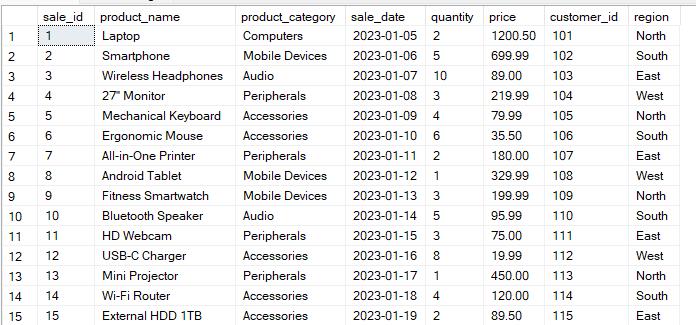
The query below groups the data by region and product_category columns. Then it calculates the total_sales for each group combination.
-- Group Sales by region and product category
SELECT region, product_category, SUM(quantity) AS total_sales
FROM Sales
GROUP BY region, product_category;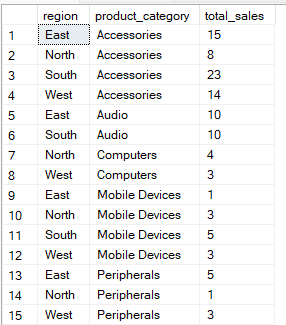
Advanced syntax variations
Below are the different methods you can use the GROUP BY clause on multiple columns in SQL:
- Numbered column references: Instead of using column names, SQL allows you to indicate the position of columns in the
GROUP BYclause. From our previous example,1refers to theregioncolumn and2to theproduct_categorycolumn. Numbered column references in GROUP BY are supported in MySQL and PostgreSQL, but not in SQL Server T‑SQL.
-- Group Sales by region and product category
SELECT region, product_category, SUM(quantity) AS total_sales
FROM Sales
GROUP BY 1, 2;
- Expression-based grouping: You can also group by derived expressions or computed values. This is useful for grouping by transformed data, such as year from a date or substrings. For example, the query below groups the sales by month derived from
sale_datein SQL Server.
-- Group Sales by month derived from date column
SELECT
DATENAME(MONTH, sale_date) AS sale_month,
COUNT(*) AS total_orders
FROM Sales
GROUP BY DATENAME(MONTH, sale_date), MONTH(sale_date)
ORDER BY MONTH(sale_date);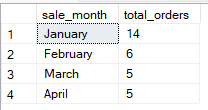
If you are using PostgreSQL, you will use the following query to output the above table.
-- Group Sales by month derived from the date column
SELECT
TO_CHAR(sale_date, 'Month') AS sale_month,
COUNT(*) AS total_orders
FROM sales
GROUP BY TO_CHAR(sale_date, 'Month'), EXTRACT(MONTH FROM sale_date)
ORDER BY EXTRACT(MONTH FROM sale_date);Similarly, MySQL uses the MONTHNAME() function to group the sales by month derived from the sale_date column.
-- Group Sales by month derived from the date column
SELECT
MONTHNAME(sale_date) AS sale_month,
COUNT(*) AS total_orders
FROM sales
GROUP BY MONTHNAME(sale_date), MONTH(sale_date)
ORDER BY MONTH(sale_date);- Selecting multiple columns but grouping by only one: SQL allows you to select multiple columns while grouping by only one, but only if the additional columns are used inside aggregate functions. In the example below, only
regionis in theGROUP BYclause, whileproduct_idis used in an aggregate function(COUNT(DISTINCT)), making the query valid.
-- Group Sales by region only
SELECT region, COUNT(DISTINCT sale_id) AS total_sales
FROM Sales
GROUP BY region;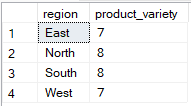
I recommend trying our Analyzing and Formatting PostgreSQL Sales Data project to understand how to manipulate data in PostgreSQL. Also, the MySQL Basics Cheat Sheet will be a handy reference guide to basic querying tables, filtering data, and aggregating data, especially if you prefer using MySQL.
Aggregate Functions with GROUP BY
The advantage of the GROUP BY clause in SQL is that you can use it with aggregate functions to get a summary of grouped data.
Common aggregate functions in multi-column grouping
The aggregate functions offer multi-dimensional insights across various data combinations when grouping by multiple columns. These are the commonly used functions with the GROUP BY clause:
- SUM(): Adds up all values in a numeric column for each group.
- COUNT(): Counts the number of rows or non-null values in each group.
- AVG(): Calculates the average value within each group.
- MIN(): Finds the smallest value in each group.
- MAX(): Finds the largest value in each group.
For example, the query below calculates the total sales and count of sales records for each combination of region and product category
-- Group by region, product_category then aggregate
SELECT region, product_category, SUM(quantity) AS total_sales, COUNT(*) AS sales_count
FROM Sales
GROUP BY region, product_category;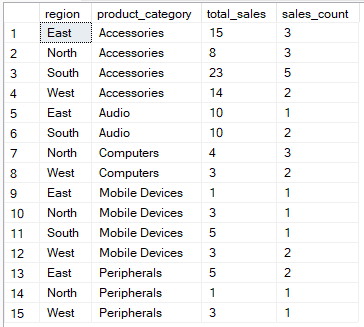
GROUP BY without aggregate functions
In the examples above, you saw how the GROUP BY clause is typically used with aggregate functions. However, when used without aggregates, GROUP BY simply returns one row for each distinct combination of the grouped columns, effectively the same as running SELECT DISTINCT on those columns.
For instance, the query below returns unique pairs of region and product category without performing any aggregation. This approach can be handy when you want to quickly verify data consistency.
--Group by multiple columns without aggregate
SELECT region, product_category
FROM Sales
GROUP BY region, product_category;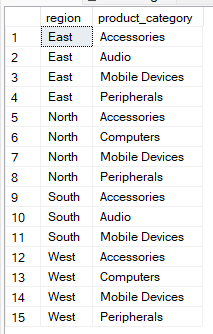
Advanced Grouping Features
Now that we have looked at how we can group by multiple columns, let’s look at the different advanced grouping operations used with the GROUP BY clause.
ROLLUP operation
The ROLLUP operation builds on the standard GROUP BY clause by creating summary levels that roll up along the specified columns. Besides showing detailed groups, it also adds subtotals and a grand total by aggregating step-by-step from right to left through the columns you group by.
For example, in the query below, you get the total_quantity for each combination of region and product_category. The results include subtotals for each region (where product_category appears as NULL) and a grand total that sums everything across all regions and categories.
-- Group by region, product_category and ROLLUP by region
SELECT region, product_category, SUM(quantity) AS total_quantity
FROM Sales
GROUP BY ROLLUP(region, product_category);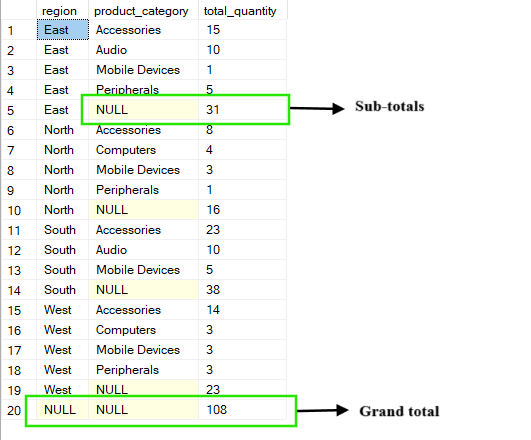
The above query works in SQL Server, PostgreSQL, and Oracle. If you are using a MySQL database, you attach the WITH ROLLUP after the GROUP BY clause.
-- Group by region, product_category and ROLLUP by region
SELECT
region,
product_category,
SUM(quantity) AS total_quantity
FROM sales
GROUP BY region, product_category WITH ROLLUP;CUBE operation
The CUBE operation generates all the possible combinations of the grouping columns. Unlike the ROLLUP operation, which produces a hierarchy, CUBE produces a complete data cube of aggregations.
It provides a cross-tabulation of aggregations for every subset of the specified columns. The output of the CUBE operation includes summaries for each column, every combination of columns, and the grand total.
For example, if we query the above table and group by the columns (region, product_category), the CUBE operation will produce the following combinations:
- (
region,product_category) - (
region,NULL) - (
NULL,product_category) - (
NULL,NULL) which is the grand total
-- Group by multiple columns using CUBE operation
SELECT region, product_category, SUM(quantity) AS total_quantity
FROM Sales
GROUP BY CUBE(region, product_category);The CUBE() operation is supported in SQL Server, Oracle, and PostgreSQL databases.
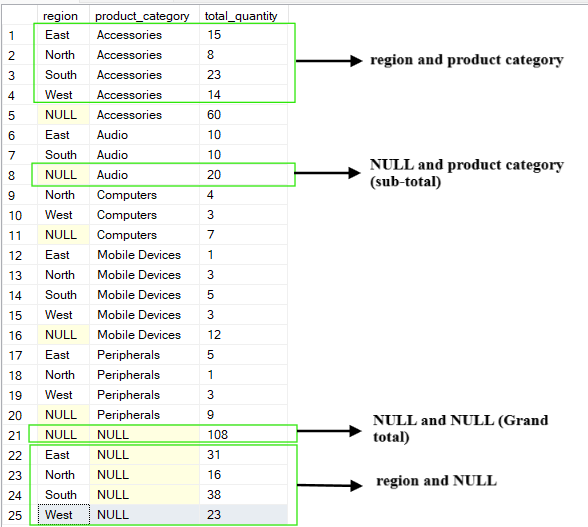
GROUPING SETS and metadata
If you want a more flexible control over how your data is grouped, then the GROUPING SETS operation allows you to explicitly define multiple groupings in a single query.
In this case, the GROUPING() function provides metadata about which columns are aggregated in each row of the result, identifying NULLs that represent subtotal or total rows rather than actual missing data.
-- Group by multiple columns using GROUPING SETS operation
SELECT region, product_category, SUM(quantity) AS total_quantity,
GROUPING(region) AS region_grouping,
GROUPING(product_category) AS product_grouping
FROM Sales
GROUP BY GROUPING SETS (
(region, product_category),
(region),
(product_category),
()
);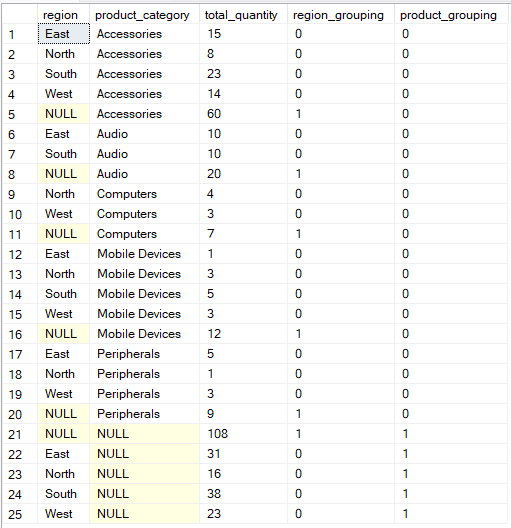
Performance Considerations and Optimization
When writing queries that group by multiple columns, it’s important to optimize them for better efficiency and overall database performance. Below are some practical tips that I have used to help with query optimization and resource management
Query optimization techniques
To keep your queries running smoothly and using minimal resources:
- Identify performance bottlenecks:
GROUP BYqueries can slow down when dealing with large datasets because of scanning, sorting, and aggregating lots of data. To avoid this issue, always filter early with aWHEREclause and avoid fetching data you don’t need. - Use indexing effectively: Indexing columns speeds up the
GROUP BYperformance. Creating composite indexes on the columns used in theGROUP BYclause helps the database engine quickly locate and group rows without expensive full table scans or sorts. - Limit columns: Only include columns necessary for your grouping and analysis to reduce complexity and improve performance.
- Leverage query plans: Where available, check execution plans or use query hints to guide the database optimizer towards the best strategies.
Memory allocation and computational resources
Memory plays a big role in how well GROUP BY queries perform. Sorting and grouping data often require holding intermediate data in memory. If there’s not enough memory, things slow down considerably.
To manage resources better:
- Ensure your database has enough memory allocated to handle these aggregation tasks.
- Use parallel processing features, if your database supports them, to spread the workload across multiple CPUs.
- Keep an eye on temporary storage and cache usage to avoid bottlenecks.
Also, remember that the size of your data has a big impact on performance. Large datasets with many unique group combinations use more memory and processing power. Techniques like partitioning large tables, creating summary tables ahead of time, or using materialized views help keep things manageable.
Integration with Other SQL Clauses
The GROUP BY clause works well with other SQL clauses, making your queries more powerful and flexible. Next, you’ll see practical examples of how to combine GROUP BY with different SQL clauses to improve your analysis.
Interaction with WHERE and HAVING clauses
The WHERE clause filters rows before grouping occurs. It limits the dataset so that only the required rows are included in the aggregation process. For example, the query below groups by region and product_category` but includes records where the region is ‘North.’
-- Group by multiple columns, filter using WHERE clause
SELECT region, product_category, SUM(quantity) AS total_quantity
FROM Sales
WHERE region = 'North'
GROUP BY region, product_category;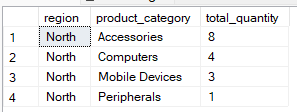
The HAVING clause, on the other hand, filters after aggregation. It's used to limit which groups appear in the final result based on aggregate values. The query below groups by region and product_category but includes records where the total_quantity is more than 5.
-- Group by multiple columns, filter using HAVING clause
SELECT region, product_category, SUM(quantity) AS total_quantity
FROM Sales
GROUP BY region, product_category
HAVING SUM(quantity) > 4;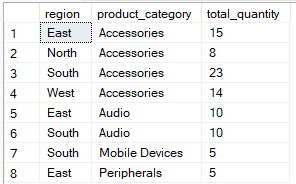
Interaction with ORDER BY and JOIN operations
In SQL order of execution, the ORDER BY clause comes after the GROUP BY clause and is used to sort the grouped results, making them easier to read or process further. By using the right indexes and carefully choosing the column order in the ORDER BY clause, you can speed up your query by cutting down on the work needed to sort the data.
For example, this query groups data by region and product_category, then sorts the results so that the groups with the highest total_quantity appear first.
-- Group by multiple columns, ORDER BY total_quantity
SELECT region, product_category, SUM(quantity) AS total_quantity
FROM Sales
GROUP BY region, product_category
ORDER BY total_quantity DESC;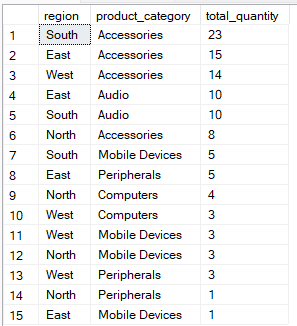
You can also combine JOIN operations with the GROUP BY clause to group data across multiple related tables. You should be careful when using this method, as it can introduce complexity due to joining data with larger sizes.
-- Retrieve the number of sales per region and product category
SELECT
c.region,
p.product_category,
COUNT(*) AS sales_count
-- Join customer, sales, and product data
FROM customers c
JOIN sales_data s
ON c.customer_id = s.customer_id
JOIN products p
ON s.product_id = p.product_id
-- Group results by region and product category
GROUP BY c.region, p.product_category
-- Order results by region first, then sales count in descending order
ORDER BY c.region, sales_count DESC;I recommend taking our Joining Data in SQL course to learn the different types of joins and how to use them in nested queries. You can download our SQL Joins Cheat Sheet guide for reference to learn more about joining data in SQL.
Interaction with CASE expressions in GROUP BY
The CASE expression in GROUP BY allows for custom groupings by transforming column values dynamically within the grouping process.
The query below categorizes products by price range and count total quantity sold per region & product category.
-- Categorize products by price range and count total quantity sold per region & product category
SELECT
region,
product_category,
-- Categorize based on product price
CASE
WHEN price >= 1000 THEN 'High-Priced Products'
WHEN price >= 500 THEN 'Mid-Priced Products'
ELSE 'Low-Priced Products'
END AS price_category,
SUM(quantity) AS total_quantity
FROM Sales
-- Group by region, product category, and price category
GROUP BY
region,
product_category,
CASE
WHEN price >= 1000 THEN 'High-Priced Products'
WHEN price >= 500 THEN 'Mid-Priced Products'
ELSE 'Low-Priced Products'
END
-- Sort results for easier interpretation
ORDER BY
region,
product_category,
total_quantity DESC;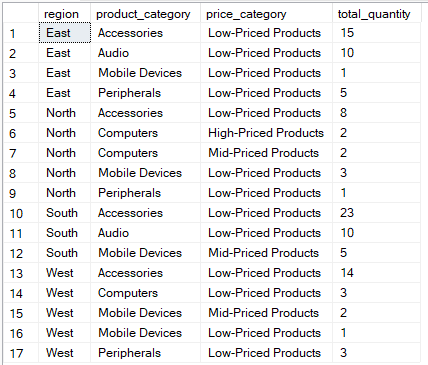
Common Patterns and Best Practices
As you continue to use the GROUP BY clause to group multiple columns, you will recognize the recurring patterns to improve your use. We will discuss these common occurrences with performance considerations.
Hierarchical and temporal analysis patterns
You may have noticed that most datasets have inherent hierarchies, such as geography (continent → country → city), product categories, or organizational structures. Therefore, the GROUP BY clause is ideal for summarizing data at different levels of these hierarchies.
When presented with data with dates and time stamps, temporal analysis can help identify trends, seasonality, and time-based behavior by grouping by date parts such as year, quarter, month, or day.
Earlier, we talked about two types of grouping patterns. Hierarchical groupings involve columns that have a natural, nested relationship, like grouping first by department, then within each department by team. In contrast, non-hierarchical groupings mix unrelated dimensions, such as product type and payment method, showing combinations without any implied order or structure.
Performance-oriented grouping patterns
When using GROUP BY with multiple columns, you can improve performance by following these practical tips:
- Limit grouping columns: Always ensure you group by columns necessary for the analysis to reduce the computational overhead of groups.
- Index optimization: Ensure that the grouped columns are indexed to speed up query performance by helping the database handle sorting operations more efficiently.
- Filter early: Use the
WHEREclause to limit your dataset before grouping to reduce the amount of data being processed. - Use query plans and hints: Review execution plans or add query hints if your database supports them to help optimize the grouping process.
- Leverage advanced SQL features: Consider using techniques like
ROLLUPorGROUPING SETSto create summaries more efficiently and avoid running repetitive queries, especially when working with hierarchical or multi-dimensional data.
Removing duplicates and data cleansing
GROUP BY can also be a handy way to clean up your data by removing duplicates based on specific fields. This is useful when your dataset has multiple identical or partially duplicate rows.
For example, to remove duplicate sales records, you will group by region, product_category, and product_name, and then select the highest price per group to keep the most relevant record.
-- Remove duplicate sales records by keeping only unique combinations
-- of region, product_category, and product_name
SELECT
region,
product_category,
product_name,
MAX(price) AS price,
SUM(quantity) AS total_quantity
FROM Sales
GROUP BY
region,
product_category,
product_name
ORDER BY
region,
product_category,
product_name;The above query summarises and selects one row per aggregate of the results, but does not remove the duplicates. If you want to remove duplicates but keep one original row, you would use the ROW_NUMBER() window function as below.
-- Remove duplicates by keeping first row per combination
WITH Deduped AS (
SELECT *,
ROW_NUMBER() OVER (
PARTITION BY region, product_category, product_name
ORDER BY sale_date ASC
) AS rn
FROM Sales
)
SELECT region, product_category, product_name, price, quantity, sale_date
FROM Deduped
WHERE rn = 1;Troubleshooting and Common Pitfalls
When working with GROUP BY on multiple columns, keep in mind these common pitfalls:
Column specification and data type issues
One of the most frequent errors in the GROUP BY queries is related to incorrect column specification. SQL requires that when selecting multiple columns not wrapped in an aggregate function, they must be included in the GROUP BY clause. Failing to do so results in an error. So, always include the non-aggregated columns in the GROUP BY clause if included in the SELECT statement.
You might also run into errors if the data you're grouping has mismatches, especially when you're grouping by expressions. Let’s assume you're grouping your data by a formatted date. In that case, you will get an error if the date values have different formats or levels of precision, leading to unexpected or incorrect results.
Performance degradation and null value handling
Using GROUP BY queries can sometimes slow down your database, especially if you’re grouping by columns with many unique values (high cardinality) or if those columns aren’t indexed. Large datasets also need enough memory to handle the sorting and grouping steps, which adds to the load.
To avoid these issues, always index the columns and filter using WHERE to limit the data you query.
Also, it’s important to know how SQL handles NULL values in grouping: all NULLs in a grouping column are treated as the same group, no matter how many there are. However, NULL is never considered equal to any actual (non-NULL) value, so those groups stay distinct.
Conclusion
Using the GROUP BY clause to group multiple columns in SQL is a powerful technique that enables deeper, multi-dimensional analysis by aggregating data across combinations of fields. It allows analysts to go beyond basic summaries and gain more insights into patterns and relationships within data. This capability is important for reporting, performance tracking, and decision-making in modern business environments..
As data grows in complexity and volume, SQL remains a foundational tool in analytics. To further enhance your skills, consider exploring window functions, common table expressions (CTEs), and materialized views, which open the door to even more advanced data transformations and reporting workflows.
I recommend taking our PostgreSQL Summary Stats and Window Functions course to learn how to write queries for business analytics using Window functions like a pro. I also challenge you to try our projects: Analyzing Industry Carbon Emissions and Analyzing Motorcycle Part Sales to test your SQL skills and demonstrate your mastery of using SQL to solve business problems.
FAQs
How can I use the HAVING clause with GROUP BY on multiple columns?
You can use the HAVING clause to filter grouped results based on aggregated values after grouping by multiple columns.
What are the differences between GROUP BY and window functions?
The GROUP BY clause collapses rows into groups, while window functions calculate over rows without reducing them, preserving row-level detail.
How can I optimize GROUP BY queries in SQL Server?
To optimize the GROUP BY clause in SQL Server, filter early using the WHERE clause, use indexed columns, avoid, and review execution plans for performance tuning.
Can you explain the use of ROLLUP and CUBE with GROUP BY?
The ROLLUP function adds subtotals along a hierarchy, while CUBE generates all combinations of grouped columns for full summary views.
How does GROUP BY handle NULL values in multiple columns?
NULL values are treated as valid group keys, meaning all rows with NULL in the same column(s) form a single group.

